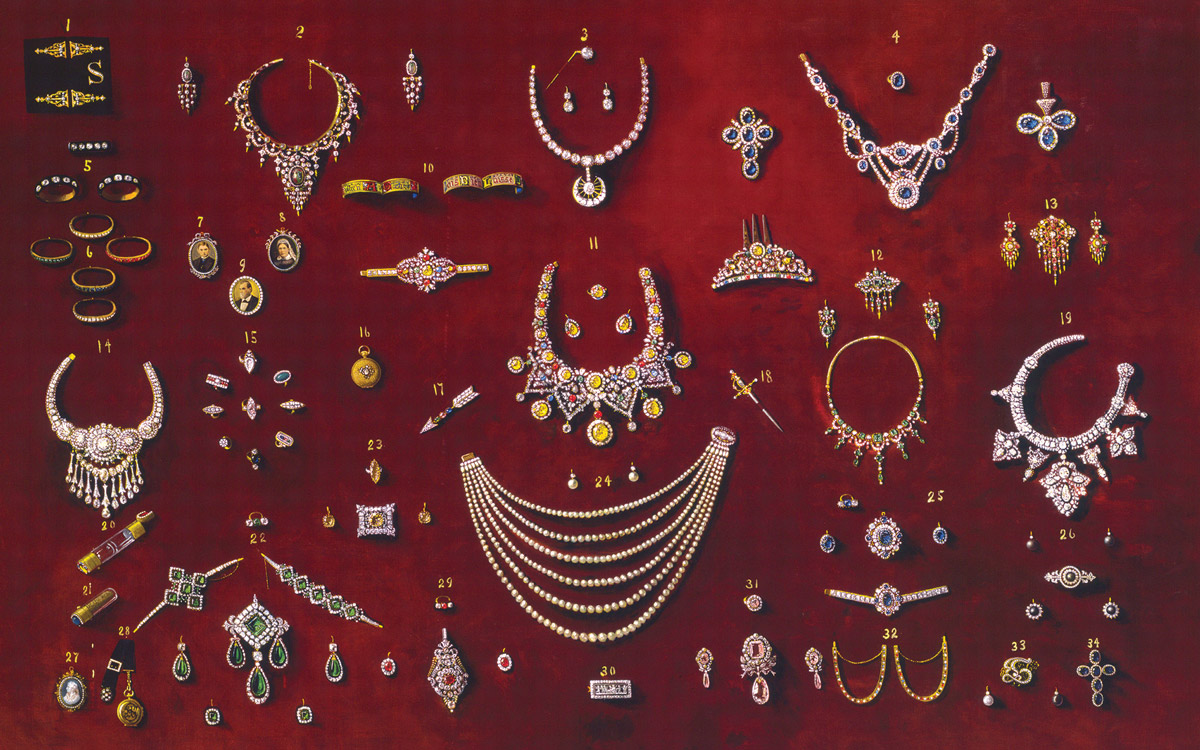Inventory / School of Rocks
Selling Mrs. Stanford’s jewels
Piper Marshall
“Inventory” is a column that examines or presents a list, catalogue, or register.

At first glance, the image above suggests nothing so much as a glossy photograph in a modern-day auction catalogue. In fact, it’s a four-by-six foot painting from 1898 titled Mrs. Stanford’s Jewel Collection, currently hanging in Stanford University’s Cantor Arts Center. Called “one of the most extraordinary still-lives of our time” by the art historian Alfred Frankenstein, the painting presents an unlikely subject—a jewelry drawer in which an array of trinkets, brooches, necklaces, and pins is assembled across a swath of maroon velvet.[1] The viewer’s position is that of a bidder peering directly into a jewelry case, its contents inventoried so as to offer themselves for documentation, delectation, and eventual acquisition.
The painting’s origins lie in financial troubles. With the assets of her deceased husband—Leland Stanford, founder of the university that bears his name—tied up in legal battles, Mrs. Stanford decided to secure funding for the nascent university’s library book fund by auctioning her jewels in London, a sale timed to take advantage of Queen Victoria’s Diamond Jubilee.[2] Mrs. Stanford wanted a photograph of the jewels, both to commemorate the precious gifts her husband had given her and to remind the students of the institution’s “benefactors”—Tiffany, Patek Philippe, and Cartier.[3] Photographed in her San Francisco residence by the renowned Taber Studio, the jewels were arranged by Stanford herself on a velvet piano cover to ensure each stone’s visibility and prominence. Enamored of the black-and-white photographic representation, Mrs. Stanford then hired A. D. M. Cooper, a saloon painter, to create a color reproduction.
Cooper, who boasted to his patron that he would “put a little fire into the sapphire,” was at best an intermittent worker, starting and stopping at least three times; on at least one occasion, he was sent home in a drunken state.[4] During his period of official inactivity, however, Cooper managed to find the time to paint a duplicate of the original on a redwood panel, which he hung in a San Jose gambling saloon. When a policeman informed Mrs. Stanford of this duplicity, she had the copy removed (its final disposition remains a mystery).[5]
All these preparations for the eventual sale of her collection notwithstanding, a poor market for jewelry in London at the time ultimately undermined Mrs. Stanford’s philanthropic efforts. While in London, she managed to sell only the Tiffany pearls and a few other small pieces. The disappointed widow had the remaining jewels returned to San Francisco, while she continued her European tour.[6]
- Bertha Berner, Mrs. Leland Stanford (Stanford: Stanford University Press, 1934).
- Carol M. Osborne, Museum Builders in the West: The Stanfords as Collectors and Patrons of Art 1870–1906 (Stanford: Stanford University Art Museum,1986), p. 67.
- Berner, p. 105.
- Ibid., p. 106.
- Ibid. Berner is unclear about the fate of the second painting, merely noting that it was “put out of sight.”
- Ibid., p. 107.
Piper Marshall is earning her B.A. at Barnard College in art history and French translation. She is currently writing her thesis on the sculptural aspects of text in Alain Robbe-Grillet’s nouveau roman and Robert Smithson’s Spiral Jetty.
Spotted an error? Email us at corrections at cabinetmagazine dot org.
If you’ve enjoyed the free articles that we offer on our site, please consider subscribing to our nonprofit magazine. You get twelve online issues and unlimited access to all our archives.